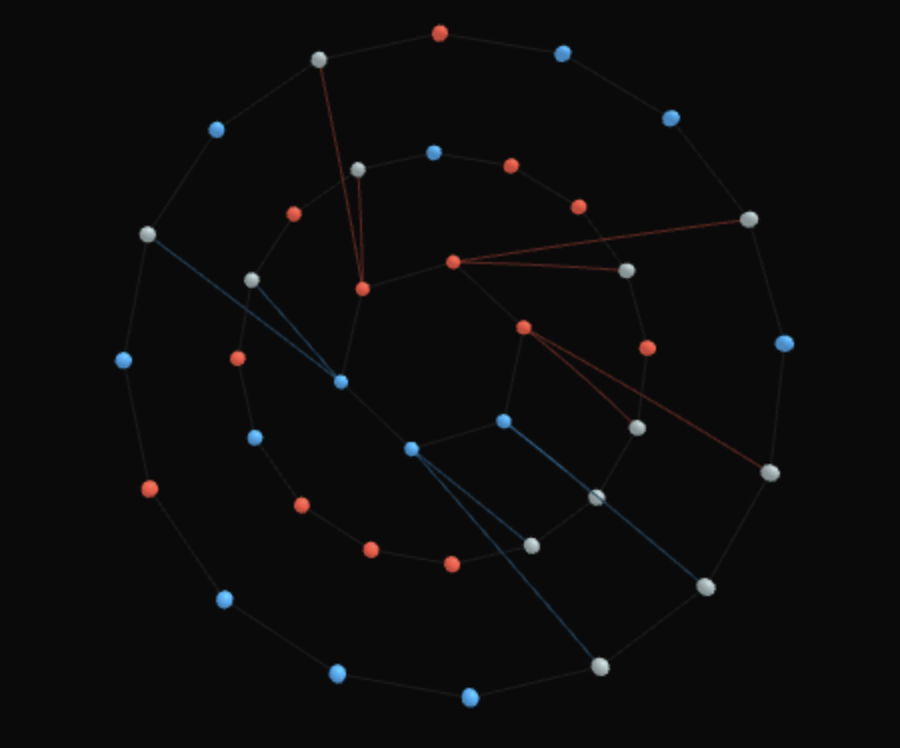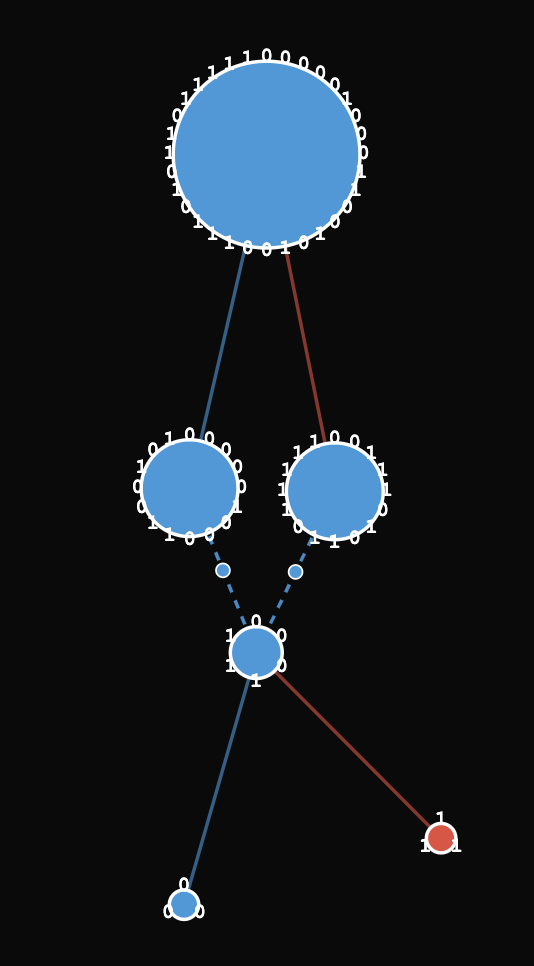Introduction to the Binary Split Game
The Binary Split Game (BSG) is a mathematical process that explores patterns in binary strings through recursive splitting operations. It provides insights into the structural complexity of binary patterns and reveals fascinating mathematical properties.
This visualization tool allows you to explore the Binary Split Game through interactive 3D and graph-based visualizations, helping you understand the underlying patterns and relationships in binary sequences.
Core Concepts
What is a Binary Split?
A binary split is an operation that takes a binary string (a sequence of 0s and 1s) and splits it into two parts according to specific rules. The process continues recursively until we reach single digits (0 or 1).
Splitting Variations
The Binary Split Game supports six different splitting variations, each with its own rules for handling the split:
| Variation | Description | Example (for "1101") |
|---|---|---|
| Variation 1 | Floor-based split, discard extra digit | 1101 → 11 + 01 → 1 + 1 + 0 + 1 |
| Variation 2 | Ceiling-based split, discard extra digit | 1101 → 110 + 1 → 11 + 0 + 1 → 1 + 1 + 0 + 1 |
| Variation 3 | Middle character split, discard middle digit | 1101 → 11 + 01 → 1 + 1 + 0 + 1 |
| Variation 4 | Floor-based split, carry forward extra digit | 1101 → 11 + 01 → 1 + 1 + 0 + 1 |
| Variation 5 | Ceiling-based split, carry forward extra digit | 1101 → 110 + 1 → 11 + 0 + 1 → 1 + 1 + 0 + 1 |
| Variation 6 | Middle character split, carry forward middle digit | 1101 → 1(1)01 → 1 + 1 + 0 + 1 |
Reduction Path
The sequence of strings produced during the splitting process is called the "reduction path." This path reveals the structural complexity of the original binary string.
Visualization Types
The Binary Split Game offers two distinct visualization types to help you understand the splitting process:
3D Cone Visualization

The 3D Cone visualization represents the binary split process as a three-dimensional structure:
- Each level of the cone represents a step in the splitting process
- Nodes represent binary strings or individual digits
- Blue nodes/connections represent 0s
- Red nodes/connections represent 1s
- Connections show the relationship between parent strings and their splits
This visualization is particularly useful for understanding the hierarchical nature of the splitting process and seeing how the original string is broken down into its constituent parts.
DAG (Directed Acyclic Graph) Visualization

The DAG visualization represents the binary split process as a network graph:
- Nodes represent binary strings or individual digits
- Solid lines show direct splitting relationships
- Dashed lines show matching relationships between strings
- Blue lines represent connections related to 0s
- Red lines represent connections related to 1s
- Gray nodes represent match points
This visualization is excellent for understanding the relationships between different strings in the reduction path and identifying patterns that might not be obvious in the 3D view.
Understanding the Metrics
The Binary Split Game provides two key metrics to quantify the complexity of binary strings:
Structural Complexity (SC)
Structural Complexity is the sum of the lengths of all strings in the reduction path. It measures how "complex" the splitting process is for a given binary string.
Reduction path: 1101 → 11 + 01 → 1 + 1 + 0 + 1
SC = 4 (length of "1101") + 2 (length of "11") + 2 (length of "01") + 1 + 1 + 1 + 1 = 12
Depth
Depth is the number of reduction steps in the binary split process. It measures how many splitting operations are needed to reach single digits.
Step 1: 1101 → 11 + 01
Step 2: 11 → 1 + 1, 01 → 0 + 1
Depth = 2
These metrics provide quantitative insights into the structural properties of binary patterns and can be used to compare different binary strings.
Controls & Features
Input Controls
- Binary Input: Enter any binary string (sequence of 0s and 1s)
- Play Button: Generate and animate the visualization
- Sequence Presets: Select from predefined interesting binary sequences
- Copy Shareable Link: Generate a link that others can use to view the same visualization
- Save Image: Download a snapshot of the current visualization
Visualization Type Selection
- 3D Cone View: Three-dimensional hierarchical visualization
- DAG Graph View: Network graph visualization showing relationships
Animation Controls
- Play: Start or resume the animation
- Pause: Pause the current animation
- Reset: Return to the initial state
- Show All: Skip the animation and show the complete visualization
- Speed Control: Adjust the animation speed
Interactive Features
- Rotation & Zoom: Click and drag to rotate the 3D view, scroll to zoom
- Pan & Zoom: Click and drag to pan the DAG view, scroll to zoom
- Tooltips: Hover over nodes and connections to see detailed information
- Node Dragging: In DAG view, drag nodes to rearrange the layout
Frequently Asked Questions
Q: What is the significance of the Binary Split Game?
A: The Binary Split Game provides insights into the structural complexity of binary patterns. It helps us understand how information is organized in binary systems and reveals mathematical patterns that might not be obvious from looking at the raw binary strings.
Q: Why are there different splitting variations?
A: Different splitting variations allow us to explore alternative ways of breaking down binary strings. Each variation can reveal different patterns and properties, providing a more comprehensive understanding of the structural complexity of binary sequences.
Q: How do I interpret the DAG visualization?
A: The DAG visualization shows the relationships between different strings in the reduction path. Solid lines represent direct splitting relationships, while dashed lines show matching relationships. The color of the lines indicates whether they're related to 0s (blue) or 1s (red).
Q: What binary strings are most interesting to explore?
A: Strings with patterns like repeated digits (e.g., "111111"), alternating digits (e.g., "101010"), or mathematical sequences (e.g., prime number representations) often reveal interesting structures. The sequence presets in the tool include several fascinating examples to explore.
Q: How can I share my findings with others?
A: Use the "Copy Shareable Link" button to generate a URL that contains your current binary input. You can also use the "Save Image" button to download a snapshot of the visualization for sharing in documents or presentations.
Advanced Concepts
BSG Spectral Analysis
The Binary Split Game can be used for spectral analysis of binary patterns, revealing hidden structures and properties. By analyzing the reduction paths and metrics across different binary strings, researchers can identify patterns and relationships that provide insights into the nature of binary information.
Applications
The concepts explored in the Binary Split Game have applications in various fields:
- Information Theory: Understanding the structural complexity of binary information
- Cryptography: Analyzing patterns in binary data for security applications
- Data Compression: Identifying redundancies and patterns in binary data
- Number Theory: Exploring properties of numbers represented in binary form
- Educational Tool: Teaching concepts of recursion, binary representation, and algorithmic thinking